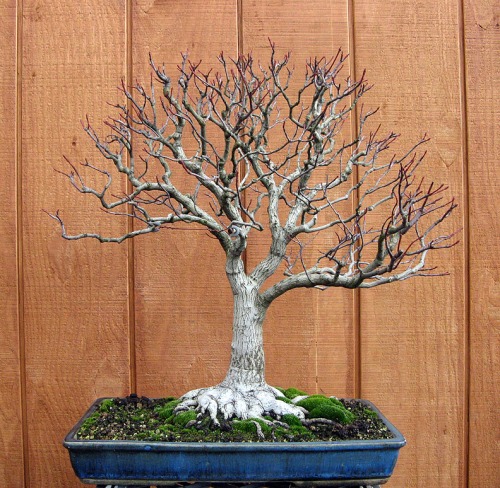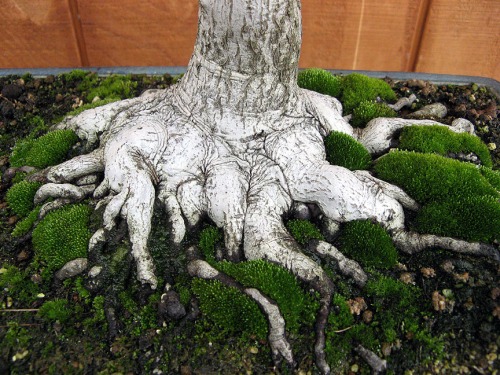This is the same tree as the previous post. I’d taken that picture in leaf, took a trip, and when I came back it was completely bare. Here’s a winter silhouette, and, since several commented on it, a close-up of the nebari.
Read more!
Showing posts with label nebari. Show all posts
Showing posts with label nebari. Show all posts
Monday, October 31, 2011
Friday, February 25, 2011
Bonsai tree: Character, Strength & Boon’s Transplanting Tips

Though it has the raw look of yet to be refined tree, still, there’s a lot to like about this tree. Its massive nebari ads great strength, character and balance and the hollow in the trunk (sabamiki) provides a further touch of character and age that sets it apart from more ordinary bonsai. It belongs to Boon Manakitivipart, owner of Bonsai Boon and distinguished bonsai artist and teacher. Though Boon doesn’t say what it is, I’ll guess that it’s a California live oak of some sort (Quercus suber?).

From a bonsai tip entitled WINTER CARE: REPOTTING, by Boon that appears at his website, Bonsai Boon.
The last thing on your mind
If you don’t live in the San Francisco Bay Area or some other place with idyllic weather (relative to Vermont, at least), repotting your bonsai may be the last thing on your mind while you are thawing out by a fire or out shoveling snow*. Still, don’t put off thinking too long; even those of us who repot in May need to plan and get our materials together.
What Boon has to say
“Start repotting your bonsai now in the San Francisco Bay Area. Some of us have already repotted all type of bonsai in December. If you are not in the Bay Area, the best time to repot deciduous trees is after the buds start to swell, but before the leaves open; but do not wait too long. It is not safe to repot after the buds have opened.”
“Among deciduous trees, flowering apricots and Japanese maples are repotted first. Japanese beech is the last to be done because its buds open later than buds on other deciduous trees (do not wait until you see the buds swell; it may be too late). Repotting should be done by middle part to the end of February (remember, he’s still in the Bay Area). Trident maples can be repotted as long as new leaves still have a reddish color”(visit Bonsai Boon for the entire article).
*Most of you don’t have to wait until May. Just us poor slobs who made the unfortunate decision to move halfway to Siberia (from the SF Bay Area no less); a decision we come to loath every year until the buds break in May, when we start thinking it was the best decision we ever made.
Source: Bonsai Bark Read more!
Tuesday, November 23, 2010
Bonsai tree: Rules of Bonsai?

Though I don’t think this has much to do with ‘rules of bonsai,’ I like a well done bonsai drawing and this one qualifies. I found it here. The post is titled ‘?5º Workshop Bonsai Morro Velho.’
Wednesday, June 16, 2010
Bonsai tree:Lonesome Maple
This is an image I’ve wanted to create for many years, just waiting for the right bonsai tree I guess, and my friend Peter Warren had this beautiful , elegant, maple for sale. It was perfect for the image I had in mind, although maybe not so old, yet, it has a wonderful nebari, very elegant trunkline, needs more work on the branching and ramification, and the trunk texture needs ageing, it just needs time, and care, to mature.
I first saw this image in John Naka’s book several years ago, I love solitary trees in nature and this is my attempt to recreate the feeling of space.


 Read more!
Read more!
I first saw this image in John Naka’s book several years ago, I love solitary trees in nature and this is my attempt to recreate the feeling of space.


 Read more!
Read more!
Friday, April 30, 2010
Bonsai tree: Flowering Bonsai #3

I’m not sure what this is and I apologize for the somewhat blurry image. Beyond that, it’s another example of a flowering bonsai that is designed to show off its flowers rather than its bonsai chops. In fact, without its flowers, it’s quite conventional with its commercial spiral S shape and funky nebari. I got it from the April page on our 2010 bonsai calendar.

Aha! A little better. This satsuki azalea holds its own as a bonsai, with or without flowers. I borrowed the image from Classic Bonsai of Japan, a one-of-a-kind standard that never goes out of date.
Source: Bonsai Bark Read more!
Wednesday, February 24, 2010
Bonsai repoting: ume
Several years passed – no flowers. I’d already carved away the lower 3-4 inches of the trunk and begun developing the nebari. I carved the trunk and helped new branches ramify. But no blooms. I’ll admit I am no fan of double pink, but the point of ume is the contrast between new flowers and old trunk. So I started grafting.
Another 5 years passed. The tree looked great with white blossoms – the fragrance was unforgettable – and I would had fun learning how to care the variety. But ume don’t bud back well, and the grafting became a regular affair. Then, out of nowhere, a few dark buds appeared from some of the original branches. Before long, I saw the first few double pink flowers. Which confirmed my decision to graft.
This year I am mid-re-grafting the entire tree. I let the branches grow past where I can safely cut back so I am essentially starting from scratch. Here is the tree a few weeks ago with the last few white and pink blossoms.

Another 5 years passed. The tree looked great with white blossoms – the fragrance was unforgettable – and I would had fun learning how to care the variety. But ume don’t bud back well, and the grafting became a regular affair. Then, out of nowhere, a few dark buds appeared from some of the original branches. Before long, I saw the first few double pink flowers. Which confirmed my decision to graft.
This year I am mid-re-grafting the entire tree. I let the branches grow past where I can safely cut back so I am essentially starting from scratch. Here is the tree a few weeks ago with the last few white and pink blossoms.

Ume – early February
Read more!
Sunday, February 21, 2010
Bonsai tree: ficus microcarpa

This tree isn’t exactly eccentric, but it's just powerful, handsome and unique. It’s by Budi Sulistyo and graces the cover of his excellent tropical bonsai gallery book.
I think this next tree falls into the eccentric category.

This ficus microcarpa by Budi Sulisyo from an album entitled ‘Stone Pot’.
This tree falls short of some of Budi’s other trees. I imagine that he posted it to show trees in stone pots. Or just to break with convention or maybe to encourage those of us who aren’t big time bonsai artists to not be afraid to show our trees.
First, it is eccentric and that’s what this series is about. Second, the trunk is heavy and has some movement and character. Third, the leaves are well developed, fairly small and healthy looking. Fourth, there looks to be a pretty good nebari, but it’s hard to tell in the photo.
The comments above are just a few quick impressions. I have too much respect for Budi to simply dismiss anything he does, let alone file criminal charges.

It features some of best tropical bonsai anywhere by some serious bonsai heavy weights from Asia and beyond. Read more!
Thursday, February 18, 2010
Nebari bonsai: trident maple

Do you like this nebari, or is it a bit much? If you just look at the bottom photo, does the nebari seem to strong for the trunk? That’s the way it strikes me, but when I look at the whole tree, it works just fine.

Here is another nebari that we featured in an earlier post. This one does seem a bit over the top, though I suspect it will look a little less dominant when the tree is in leaf. What do you think? This is a trident maple. Read more!
Monday, January 18, 2010
Ficus Gallery

This powerfuly built gem is from Ficus, the Exotic Bonsai. It looks like to be a Benjamina cultivar.
Big ficus fan
If you want to grow bonsai indoors, you will be hard pressed to find subjects beter suited than ficus, though some varieties are better suited than others. I have also had some luck with the Willow Leaf ficus. If you have any experience with other varieties, let us know.

This is a large Willow leaf ficus with some impresive aerial roots.

This is a large Benjamina with a well developped nebari.

This is a simple Willow leaf planting. Though it is far from a masterpiece, it does have some charm and is the type of project that almost any beginner might attempt and that's for sure. Read more!
Subscribe to:
Posts (Atom)

